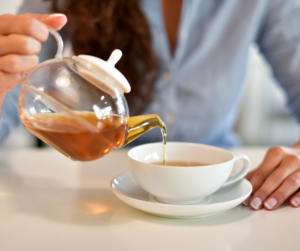==================
A Caveat and Affiliates
First off, a little caveat: within my articles you will find affiliate links, meaning if you buy them, I get a small commission. Your cost is not affected. In addition, I am an Amazon Associate and I earn from qualifying purchases on Amazon.
And yes, if I say that I recommend a product here, it means I truly believe it is a good product. I refuse to recommend any product that I have not researched and believe to be a good value.
Even better, I provide you with a very clear picture of the product, it’s use, and the probable value.
Earning your trust is important to me. I run this website myself and the commissions and donations help support the site.
Sound reasonable and fair enough? Let’s continue to the article.
==================
Contents
Elevate Your Pu Erh Tea Experience: Proven Brewing Tips for a Rich and Flavorful Brew
Do you love to sip on Pu Erh tea instead of your coffee? Then, you will love learning about the Pu Erh Tea Brewing Tips in this article today.
We hope you’ll enjoy this article about Pu Erh Tea Brewing Tips we use to make this tea every morning.
Introduction to Pu Erh Tea
Pu Erh tea is a unique and exquisite tea originating from the Yunnan province in China. Renowned for its distinct flavor and numerous health benefits, Pu Erh tea has gained worldwide popularity among enthusiasts. This article aims to guide you on how to brew Pu Erh tea correctly, ensuring you can enjoy a rich and flavorful cup every time.
The Importance of Brewing Tea Correctly
 Brewing tea correctly is crucial to unleash its full potential and flavor. Each type of tea requires specific brewing techniques to bring out its unique characteristics. Following the proper brewing methods can enhance your tea’s taste, aroma, and health benefits. Whether you are a beginner or an experienced tea drinker, understanding the art of brewing tea is essential to elevate your tea experience.
Brewing tea correctly is crucial to unleash its full potential and flavor. Each type of tea requires specific brewing techniques to bring out its unique characteristics. Following the proper brewing methods can enhance your tea’s taste, aroma, and health benefits. Whether you are a beginner or an experienced tea drinker, understanding the art of brewing tea is essential to elevate your tea experience.
General Brewing Tips for All Types of Tea
Before diving into the specific brewing tips for Pu Erh tea, let’s start with some general tips that apply to all types of tea. First and foremost, always use fresh, high-quality water. The water you use can significantly impact the taste of your tea, so it’s important to use filtered or spring water whenever possible. Additionally, preheat your teapot or teacup by rinsing it with hot water before brewing. This helps maintain the optimal temperature for steeping.
Next, pay attention to the water temperature and steeping time. Different types of tea require different water temperatures and steeping durations to achieve the best flavor. For example, green tea should be brewed at a lower temperature, around 160°F to 180°F (70°C to 82°C), and steeped for 2 to 3 minutes.
On the other hand, black tea generally requires hotter water, around 200°F to 212°F (93°C to 100°C), and a longer steeping time of 3 to 5 minutes. Experimenting with different steeping times and temperatures will help you find the perfect balance for your taste preferences.
Lastly, never underestimate the importance of using the right amount of tea leaves. Too little tea will result in a weak and tasteless brew while using too much can make the tea overpowering and bitter. As a general guideline, use one teaspoon of loose tea leaves for every 8 ounces (240 ml) of water. Adjust the amount according to your personal preference and the strength of the tea you desire.
Brewing Tips for Pu Erh Tea
 Now that we’ve covered the general brewing tips let’s focus on Pu Erh tea. Pu Erh tea comes in two main types: raw (sheng) Pu Erh and ripe (shou) Pu Erh. Both types require slightly different brewing techniques to appreciate their distinct flavors fully.
Now that we’ve covered the general brewing tips let’s focus on Pu Erh tea. Pu Erh tea comes in two main types: raw (sheng) Pu Erh and ripe (shou) Pu Erh. Both types require slightly different brewing techniques to appreciate their distinct flavors fully.
For raw Pu Erh tea, it is recommended to rinse the leaves before brewing. This helps to remove any impurities and awaken the flavors. Start by pouring hot water over the leaves and immediately draining it. After the rinse, steep the tea for 30 seconds to a minute for the first infusion.
Gradually increase the steeping time for subsequent infusions as the leaves unfold and release more flavors. Raw Pu Erh tea can be steeped multiple times, with each infusion offering a different taste profile.
On the other hand, ripe Pu Erh tea does not require a rinse. Simply steep the leaves for 2 to 3 minutes for the first infusion and adjust the steeping time for subsequent infusions based on your preference. Ripe Pu Erh tea tends to have a mellow and earthy flavor and can be steeped multiple times.
Brewing Tips for Green Tea
Green tea is known for its delicate flavors and numerous health benefits. To brew the perfect cup of green tea, start by using water at a lower temperature, around 160°F to 180°F (70°C to 82°C).
Steep the tea for 2 to 3 minutes to avoid bitterness. Green tea leaves are delicate and can become bitter if steeped for too long or with too hot water. Experiment with different green tea varieties and adjust the brewing time and temperature to find your preferred taste.
Brewing Tips for White Tea
 White tea is the least processed tea, making it delicate and subtle in flavor. To brew white tea, use water at a lower temperature, around 160°F to 180°F (70°C to 82°C). Steep the tea for 3 to 5 minutes to bring out its delicate flavors. White tea can be enjoyed alone or with honey for a naturally sweet taste.
White tea is the least processed tea, making it delicate and subtle in flavor. To brew white tea, use water at a lower temperature, around 160°F to 180°F (70°C to 82°C). Steep the tea for 3 to 5 minutes to bring out its delicate flavors. White tea can be enjoyed alone or with honey for a naturally sweet taste.
Remember to adjust the brewing time and temperature according to your preference and the specific variety of white tea you are brewing.
Brewing Tips for Black Tea
Black tea is known for its robust and bold flavors. To brew black tea, use water at a higher temperature, around 200°F to 212°F (93°C to 100°C). Steep the tea for 3 to 5 minutes for a solid and flavorful cup. Black tea can be enjoyed plain or with a splash of milk and a hint of sweetener. Feel free to experiment with different black tea varieties and find the perfect balance of strength and flavor that suits your palate.
Brewing Tips for Herbal Iced Tea
Herbal iced tea is a refreshing and caffeine-free alternative to traditional tea. To brew herbal iced tea, start by steeping your favorite herbal blend in hot water for about 5 to 7 minutes.
After steeping, strain the tea leaves and let the tea cool to room temperature. Once cooled, transfer the tea to a pitcher and refrigerate for a few hours.
Serve the herbal iced tea over ice and garnish with fresh fruits or herbs for an extra flavor. Feel free to experiment with herbal tea blends and create signature iced tea recipes.
How to Store Pu Erh Tea
Proper storage is essential to maintain the quality and flavor of Pu Erh tea. Store your Pu Erh tea in a cool, dark, and dry place, away from strong odors. Avoid sunlight, heat, and moisture exposure, as they can degrade the tea leaves and affect the taste.
Many Pu Erh enthusiasts store their tea in ceramic or clay containers, providing a stable and breathable environment.
Additionally, it is recommended to keep different Pu Erh teas separate to avoid flavor contamination. Pu Erh tea can age gracefully with proper storage and develop complex flavors over time.
Conclusion
 Following these proven brewing tips, you can elevate your Pu Erh tea experience and enjoy a rich and flavorful brew every time. Remember to pay attention to the water temperature, steeping time, and the amount of tea leaves used. Experiment with different brewing techniques and adjust them according to your taste preferences.
Following these proven brewing tips, you can elevate your Pu Erh tea experience and enjoy a rich and flavorful brew every time. Remember to pay attention to the water temperature, steeping time, and the amount of tea leaves used. Experiment with different brewing techniques and adjust them according to your taste preferences.
Whether you’re brewing Pu Erh tea, green tea, white tea, black tea, or herbal iced tea, the art of brewing tea correctly will enhance your tea journey and allow you to savor the unique flavors of each cup. So, grab your favorite tea leaves, brew a cup, and embark on a delightful tea adventure. Cheers!
More From Tea Jubilee.
Brewing The Perfect Pot of Tea
HOW TO BREW TEA PERFECTLY EVERY TIME
Steep Your Way to Hot Tea Perfection
The Definitive Guide to Tea Brewing
And that’s all for today. Thank you for reading about Pu Erh Tea Brewing tips. We hope you’ll check out the links from Tea Jubilee. And we love hearing from our readers so feel free to leave a comment below with your thoughts about Pu Erh Tea Brewing Tea Tips.
Have a great day!




